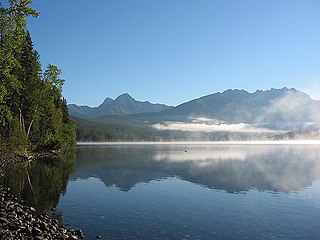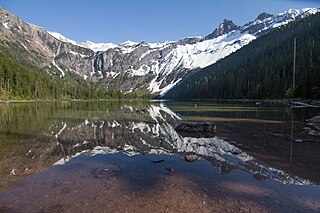
Glacier County is located in the U.S. state of Montana. As of the 2020 census, the population was 13,778. The county is located in northwestern Montana between the Great Plains and the Rocky Mountains, known to the Blackfeet as the "Backbone of the World". The county is geographically and culturally diverse and includes the Blackfeet Indian Reservation, Glacier National Park, and Lewis and Clark National Forest. The county is bordered by 75 miles of international boundary with two ports of entry open year-round and one seasonal international border crossing into Alberta, Canada.

Flathead County is in the U.S. state of Montana. At the 2020 census, its population was 104,357, making it the state's fourth most populous county. Its county seat is Kalispell. Its numerical designation is 7. Its northern border is on the state's north border, making it contiguous with the Canada–US border, facing British Columbia.

The Continental Divide of the Americas is the principal, and largely mountainous, hydrological divide of the Americas. The Continental Divide extends from the Bering Strait to the Strait of Magellan, and separates the watersheds that drain into the Pacific Ocean from those river systems that drain into the Atlantic and Arctic oceans.

Glacier Peak Wilderness is a 566,057-acre (229,075 ha), 35-mile-long (56 km), 20-mile-wide (32 km) wilderness area located within portions of Chelan, Snohomish, and Skagit counties in the North Cascades of Washington. The area lies within parts of Wenatchee National Forest and Mount Baker National Forest and is characterized by heavily forested stream courses, steep-sided valleys, and dramatic glacier-crowned peaks. The dominant geologic feature of the area is 10,541-foot (3,213 m) Glacier Peak. It is the most remote major volcanic peak in the Cascade Range and has more active glaciers than any other place in the lower forty-eight states. Glacier Peak is a volcanic cone of basalt, pumice, and ash which erupted during periods of heavy glaciation.

Kintla Peak is a pyramidal peak in the Livingston Range of Glacier National Park in the U.S. state of Montana. It is the tallest mountain in the Livingston Range and the third-tallest in the park. It is also the most northerly peak and land area in the contiguous United States above 10,000 ft (3,000 m). The Agassiz Glacier lies below it to the southeast.

Snow Dome is a mountain located on the Continental Divide in the Columbia Icefield, where the boundary of Banff National Park and Jasper National Park meets the border of Alberta and British Columbia in Canada. The summit's elevation is 3,456 m (11,339 ft).

Bowman Lake is in the northwestern portion of Glacier National Park in Montana. The lake is accessed via a 6 miles (9.7 km) unpaved road from the small town of Polebridge. At 1,706 acres (690 ha), Bowman Lake is the third largest lake in the park, after Lake McDonald and Saint Mary Lake.

Kintla Lake is a lake in the northwestern portion of Glacier National Park in Montana. The lake is located in a rather remote portion of the park, close to the Canada–United States border. The lake is a 40 mi (64 km) drive from the west entrance along bumpy dirt roads. At 1,698 acres (687 ha), Kintla Lake is only slightly smaller than Bowman Lake, and is the fourth largest lake in the park.

Sperry Glacier is a glacier on the north slopes of Gunsight Mountain west of the Continental Divide in Glacier National Park in the U.S. state of Montana. Although many geologic features of Glacier National Park were formed during the much longer period of glaciation ending over 10,000 years ago, Sperry Glacier — like all the glaciers in the park today — is a product of the recent Little Ice Age, the period of cooler average temperatures starting in about the 13th century and concluding in the mid-19th century.

Kootenai Lakes are in Glacier National Park, in the U. S. state of Montana. The Kootenai Lakes are in the Waterton Valley in the north central section of Glacier National Park. It is commonly recognized for its trail, Kootenai Lakes Trail. It is a 5.5 mile lightly trafficked out and back trail near Babb, Montana that features one of the Kootenai lakes and is good for all skill levels. The trail is primarily used for hiking, walking, nature trips, and fishing and is best used from April until October.

Lake Frances is located in Glacier National Park, in the U. S. state of Montana. Runoff from the Dixon Glacier empties into the south side of the lake while runoff from Thunderbird Glacier flows into Thunderbird Creek and into the east shore of the lake.
Wahseeja Lake is located in Glacier National Park, in the U. S. state of Montana. The lake is just northwest of Shaheeya Peak.
Carcajou Lake is located in Glacier National Park, in the U. S. state of Montana. The lake is on the north slope of Porcupine Ridge.

Lake Wurdeman is located in Glacier National Park, in the U. S. state of Montana. The lake is northwest of Chapman Peak and .50 miles (0.80 km) east of Lake Nooney.

Lake Nooney is located in Glacier National Park, in the U. S. state of Montana. The lake is east of Mount Custer and .50 miles (0.80 km) west of Lake Wurdeman. The Herbst Glacier is located above the lake to the northwest. Rock flour (silt) from melting glaciers make the lake appear opaque turquoise in color.
Falling Leaf Lake is located in Glacier National Park, in the U. S. state of Montana. The lake is in a cirque to the north of Allen Mountain and adjacent to Snow Moon Lake.

The Mountain states form one of the nine geographic divisions of the United States that are officially recognized by the United States Census Bureau. It is a subregion of the Western United States.

Avalanche Lake is located in Glacier National Park, in the U. S. state of Montana. Avalanche Lake is southwest of Bearhat Mountain and receives meltwater from Sperry Glacier. Avalanche Lake is a 2 miles (3.2 km) hike from the trailhead along the Trail of the Cedars. When measured in August 1910, the maximum depth of the lake was 63 feet near the upper end.

Logging Lake is located in Glacier National Park, in the U. S. state of Montana. Logging Lake is one of the longest lakes in Glacier National Park at 6 miles (10 km) in length. The Lower Logging Lake Snowshoe Cabin and Boathouse are two structures located near the southwestern end of Logging Lake, and are on the National Register of Historic Places. Logging Lake is a 4.5 miles (7.2 km) hike from the Logging Lake Ranger Station.

The Regional designations of Montana vary widely within the U.S state of Montana. The state is a large geographical area that is split by the Continental Divide, resulting in watersheds draining into the Pacific Ocean, Gulf of Mexico and Hudson's Bay. The state is approximately 545 miles (877 km) east to west along the Canada–United States border and 320 miles (510 km) north to south. The fourth largest state in land area, it has been divided up in official and unofficial ways into a variety of regions. Additionally, Montana is part of a number of larger federal government administrative regions.

















